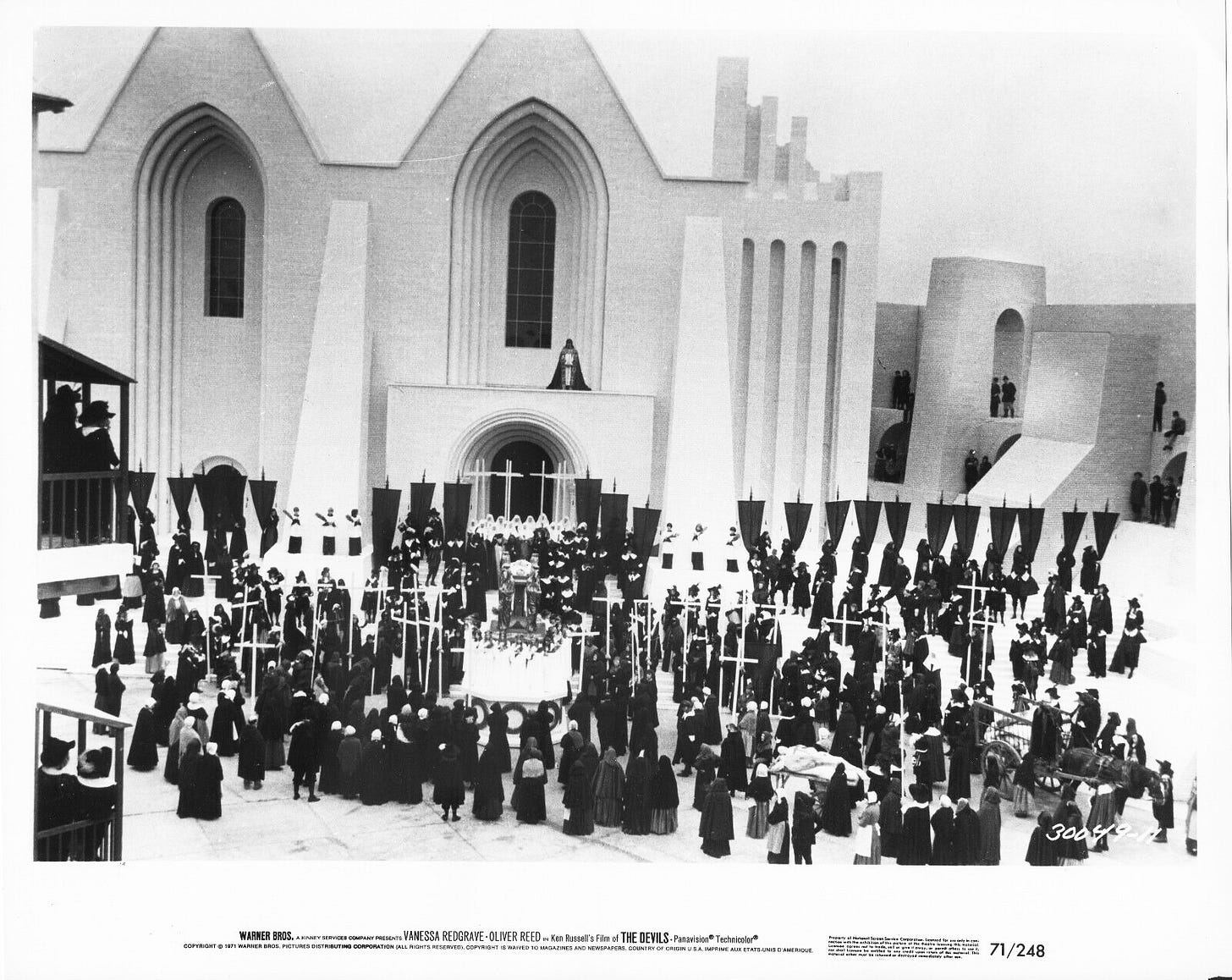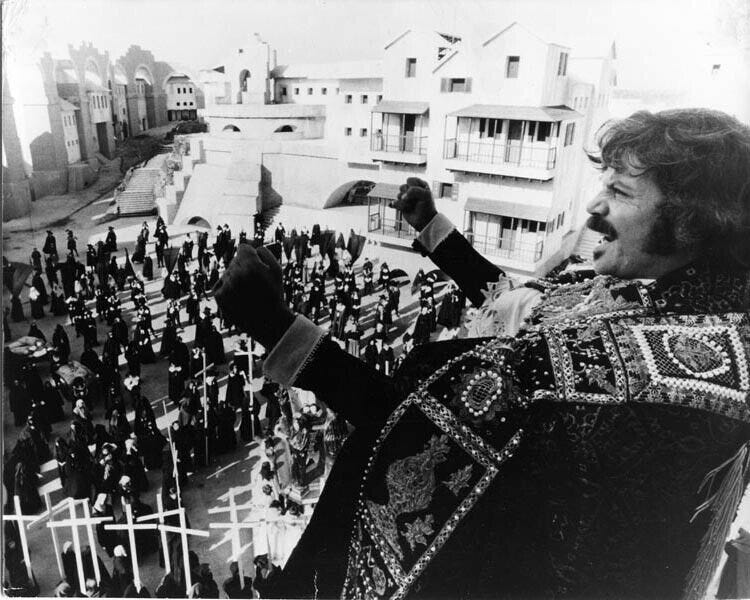Spoilers for The Devils (1971). Trigger warnings for brief discussions of sexual assault.
Still unavailable in its uncut form, The Devils, Ken Russell’s 1971 adaption of Aldous Huxley’s 1952 novel, The Devils of Loudun, is one of the most controversial films in the Warner Bros back catalogue. There is no end of scenes we could explore, from the flamboyant, gender-swapped entrance of King Louis XIII (George Armitage) which opens the film, to the now infamous scene of mass hysteria within the nunnery that inspired the source material.
But Russell, while undoubtedly a man who loved to shock and appal his audiences, brings far more to this film than simple sacrilegious imagery or boundary-pushing sexual autonomy. At its heart, The Devils is about the intertwining of church and state, and the damage this can do.
On the surface, there’s little subtlety around this. Performances are turned all the way up. Oliver Reed is on wonderful form as Father Urbain Grandier, who finds himself in the crosshairs of the catholic church for refusing to punish and remove protestants from Loudun, and for fighting attempts to bring all of France under national rule.
Vanessa Redgrave gives a strange, twitchy performance as Sister Jeanne. A severely repressed nun who fantasises about Grandier and is wilfully manipulated by the various representatives of the church (Dudley Sutton, Michael Gothard and Murray Melvin) to feign demonic possession at the hands of Grandier.
However, there is far more going on within The Devils, right down to its set design, that combines to tell a nuanced story. Working with set designer Derek Jarman (who would go on to have his own influential directorial career), Russell shunned the tried and tested design ideas of a period piece and took advantage of the substantial budget to create the largest set at Pinewood Studios since the notorious box office bomb Cleopatra.
Jarman was given a huge amount of freedom with his set designs. Russell instructed him to take modern influences because the people of Loudun would have seen themselves as a modern, vibrant community. Indeed in the film, Loudun looks completely out of place with the rest of France. The court of Louis XIII is theatrical and more in line with what audiences would have expected a period piece to look like (even as he shoots protestant prisoners, dressed up as blackbirds for his own entertainment).
Loudun on the other hand is isolated, walled away. Jarman looked to neo-classical designs, as well as impressionist cinema such as The Passion of Joan of Arc and Metropolis, to create a city that feels both historical and also completely separated in space and time.
Two instances are perhaps most obvious with this. Grandier’s speech to the populous, in which he rallies them against the increased influence of the capital, shows the city centre to be surrounded by bright, whitewashed brick walls. It evokes both an ancient coliseum and a modern stadium, with Grandier being the period’s rockstar – a womanising, charismatic leader who preaches the spirit of the gospel alongside the individuality of each resident.
This rockstar comparison becomes even more relevant when Michael Gothard’s Father Barre enters the city – looking every bit a Mick Jagger stand-in, with a flamboyant performance to boot.
More famous perhaps is the design of the nunnery. Jarman was instructed to follow a line from Huxley’s novel – ‘rape in a public toilet’ – and much of the location features stark, white tiles across the walls and floor. Given the vivid images that a public toilet can conjure in our modern lexicon, it stands in contrast with the values being pushed onto the city by the church.
Suitably it also feels like an institution, down to the bars on the windows. Its clinical feeling is supposed to represent the sedate and pious life of a nun but instead is juxtaposed against the antics of those confined within.
Russell is not coy about showing the nunnery to be a poor excuse for a prison for wayward women, even before it comes the centre of the politically driven, church-sanctioned hoax. The nuns are shown to have more autonomy than the church would like. Isolated from the rest of the city, they perform lewd enactments of third-hand news passed to them and follow the teachings and instruction of Sister Jeanne in only the most perfunctory way.
These modern flairs only help to heighten the satire. It would be easy to dismiss a straight period piece; to place the themes discussed in a time capsule that cannot be applied to our lives.
Russell refuses to let this happen with The Devils. It remains controversial and continues to be a damning critique of a combined church and state. Its power doesn’t just come from the scenes of nuns stripped nude; bizarre and misogynistic experiments to test for demonic possession; or the queasy torture and eventual burning of Grandier. These are shocking, no doubt, but taken in a vacuum, modern audiences have been desensitised to far worse.
There’s an argument that the idiosyncratic design choices made by Russell and Jarman stop this film from being ignored. Modern audiences can still find relatable aspects, both in the setting and the character, making the themes that much harder to swallow.
Director: Ken Russell
Writers: Ken Russell, based on the play by John Whiting, inspired by the novel The Devils of Loudun by Aldous Huxley
Starring: Oliver Reed, Vanessa Redgrave, Dudley Sutton









